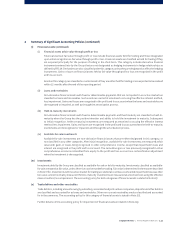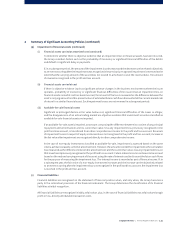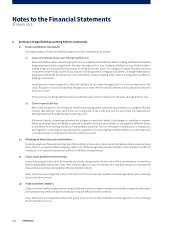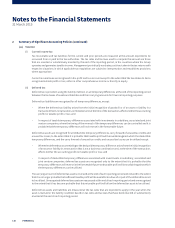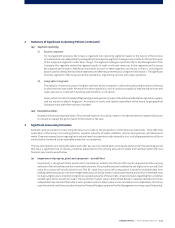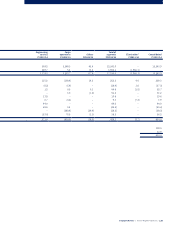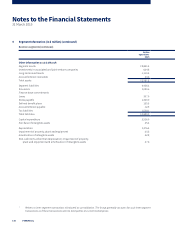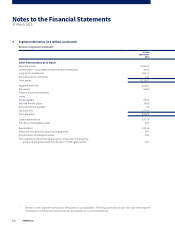Singapore Airlines 2015 Annual Report Download - page 124
Download and view the complete annual report
Please find page 124 of the 2015 Singapore Airlines annual report below. You can navigate through the pages in the report by either clicking on the pages listed below, or by using the keyword search tool below to find specific information within the annual report.
Notes to the Financial Statements
31 March 2015
2 Summary of Significant Accounting Policies (continued)
(af) Training and development costs
Training and development costs, including start-up programme costs, are charged to the profit and loss account in the
financial year in which they are incurred.
(ag) Borrowing costs
Borrowing costs incurred to finance advance and progress payments for aircra are capitalised as part of advance and
progress payments until the aircra are commissioned for operation or the projects are completed. All other borrowing
costs are recognised as finance charges in the period in which they are incurred.
(ah) Claims and liquidated damages
Claims for liquidated damages, in relation to a loss of income, are recognised in the profit and loss account when a
contractual entitlement exists, the amount can be reliably measured and receipt is virtually certain. When the claims do
not relate to a compensation for loss of income, the amounts are taken to the statement of financial position as deferred
credit, included under deferred account, as a reduction to the cost of the assets when the assets are capitalised and also
for future reduction of operating lease expenses.
(ai) Derivative financial instruments and hedging
The Group uses derivative financial instruments such as forward currency contracts, foreign currency option contracts,
cross currency swap contracts, interest rate swap contracts, interest rate cap contracts, jet fuel option contracts, jet fuel,
Brent and crack swap contracts and jet fuel collar contracts to hedge its risks associated with foreign currency, interest
rate and jet fuel price fluctuations. Such derivative financial instruments are initially recognised at fair value on the date
on which a derivative contract is entered into, and are subsequently re-measured at fair value.
Any gains or losses arising from changes in fair value on derivatives that do not qualify for hedge accounting are taken
directly to the profit and loss account.
The Group also sets aside USD deposits to match forecast capital expenditure requirements. To create a USD-denominated
asset in the statement of financial position to match against the expected USD liability for capital expenditure, the Group
accumulates USD over a period of 10 months in advance of forecast aircra payments. The exchange gains and losses of
the USD held would be recognised in the carrying value of the aircra.
At the inception of a hedge relationship, the Group formally designates and documents the hedge relationship to which
the Group wishes to apply hedge accounting and the risk management objective and strategy for undertaking the hedge.
The documentation includes identification of the hedged item or transaction, the hedging instrument, the nature of the
risk being hedged and how the Group will assess the hedging instrument’s eectiveness in osetting the exposure to
changes in the hedged item’s (or transaction’s) cash flows attributable to the hedged risk. Such hedges are expected to
be highly eective in achieving osetting changes in cash flows, and are assessed on an ongoing basis to determine that
they have been highly eective throughout the financial reporting periods for which they are designated.
Derivatives are classified as fair value through profit or loss unless they qualify for hedge accounting. Hedges which meet
the criteria for hedge accounting are accounted for as cash flow hedges.
For cash flow hedges, the eective portion of the gain or loss on the hedging instrument is recognised directly in the fair
value reserve Note 16(d), while the ineective portion is recognised in the profit and loss account.
Amounts taken to the fair value reserve are transferred to the profit and loss account when the hedged transaction aects
profit or loss, such as when a forecast sale or purchase occurs. If the hedged item is a non-financial asset or liability, the
amounts taken to the fair value reserve are transferred to the initial carrying amount of the non-financial asset or liability.
122 FINANCIAL



